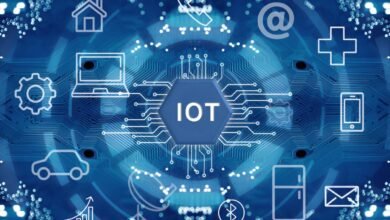
Step-by-Step Guide to Integrating IoT in Your Small Business In 2024? In the rapidly evolving landscape of business and technology, embracing the Internet of Things (IoT) has become a strategic imperative for small businesses seeking to enhance their operations, improve efficiency, and stay competitive. As we navigate through 2024, the integration of IoT presents a transformative opportunity, enabling businesses to connect devices, gather data, and derive actionable insights. This guide aims to provide a comprehensive, step-by-step approach for small business owners looking to seamlessly integrate IoT into their operations. From defining objectives to addressing security concerns and fostering a culture of innovation, this guide will help you navigate the complexities of IoT integration, empowering your business to thrive in the digital age.
Table of Contents
ToggleDefine Objectives and Use Cases
Clearly outline your business goals and identify areas where IoT can add value. Whether it’s optimizing operations, enhancing customer experience, or reducing costs, having a clear understanding of your objectives will guide the integration process.
Assess Current Infrastructure
Evaluate your existing technology infrastructure. Identify compatibility issues and ensure that your current systems can support IoT devices and data. Consider factors like network capabilities, data storage, and security.
Develop a Budget
Create a budget that covers the cost of IoT devices, software, infrastructure upgrades, and ongoing maintenance. Consider the long-term return on investment (ROI) and prioritize investments based on their potential impact on your business objectives.
Choose IoT Devices and Platforms
Select IoT devices and platforms that align with your business needs. Ensure compatibility, scalability, and the ability to integrate with existing systems. Common IoT devices include sensors, actuators, and smart devices, while platforms provide the infrastructure to manage and analyze data.
Implement Security Measures
Prioritize security to protect your business and customer data. Utilize encryption, secure network protocols, and regularly update firmware and software. Implement access controls to ensure that only authorized personnel can interact with IoT devices and data.
Build Connectivity
Establish reliable and high-speed connectivity to support the seamless operation of IoT devices. Depending on your business needs, this could involve upgrading to a faster internet connection or implementing a dedicated IoT network.
-
LoRaWAN in Germany: Use Cases and Growth Outlook25 April 2025
Develop Data Management and Analytics Strategy
Create a strategy for collecting, storing, and analyzing the data generated by IoT devices. Leverage analytics tools to gain insights that can inform business decisions. Consider cloud-based solutions for scalable data storage and processing.
Train Employees
Ensure that your employees are trained to use and manage IoT devices effectively. Provide education on security protocols and data privacy to mitigate potential risks associated with IoT integration.
Test and Optimize
Before fully deploying IoT across your business, conduct thorough testing. Identify and address any issues that arise during the testing phase. Continuously optimize your IoT ecosystem based on feedback and evolving business needs.
Monitor and Maintain
Implement a monitoring system to keep track of IoT device performance, security, and data analytics. Regularly update software and firmware to address vulnerabilities and improve functionality. Establish a maintenance schedule to address any hardware issues promptly.
By following these steps, you can systematically integrate IoT into your small business, unlocking new opportunities for growth, efficiency, and innovation. Keep in mind that IoT is a dynamic field, so staying informed about emerging technologies and industry best practices will contribute to the long-term success of your IoT implementation.
Regulatory Compliance
Understand and comply with relevant regulations and standards governing IoT in your industry and location. Ensure that your IoT implementation aligns with data protection and privacy laws to avoid legal issues.
Implement Remote Management
Enable remote monitoring and management of your IoT devices. This allows for real-time troubleshooting, updates, and maintenance, reducing downtime and improving overall system reliability.
Foster Collaboration
Encourage collaboration among different departments within your business to maximize the benefits of IoT. Engage stakeholders early in the process to gather insights and ensure a holistic approach to implementation.
Consider Energy Efficiency
Evaluate the energy consumption of your IoT devices and choose energy-efficient options where possible. This not only reduces operational costs but also aligns with sustainability goals, which can be a positive aspect for your brand.
Explore Integration with Other Technologies
Look for opportunities to integrate IoT with other emerging technologies, such as artificial intelligence (AI) and machine learning. Combining these technologies can enhance the capabilities of your IoT ecosystem and provide more advanced insights.
Read More; BlockChain Will Launch New Mining Operation With 5 nm Chips
Customer Education and Engagement
If your IoT implementation involves customer-facing devices or services, invest in educating your customers. Clearly communicate the benefits and usage of IoT-enabled products or services, and gather feedback to improve user experience.
Scalability Planning
Design your IoT infrastructure with scalability in mind. As your business grows, the demand on your IoT system will increase. Ensure that your architecture can accommodate future expansions without significant disruptions.
Continuous Improvement
Establish a culture of continuous improvement. Regularly review the performance and impact of your IoT implementation. Seek feedback from users and stakeholders, and be prepared to make adjustments based on changing business needs and technological advancements.
Data Privacy and Ethics
Prioritize data privacy and ethical considerations in your IoT strategy. Clearly communicate how customer data will be used and protected, and establish ethical guidelines for the collection and use of data.
Develop a Disaster Recovery Plan
Create a robust disaster recovery plan to address potential disruptions, such as system failures or cyber-attacks. Regularly test the plan to ensure a swift and effective response to unforeseen events.
By incorporating these additional considerations into your IoT integration strategy, you can build a resilient and forward-thinking foundation for your small business. Embracing IoT technologies with a comprehensive approach will position your business for increased efficiency, competitiveness, and innovation in the ever-evolving business landscape.
Conclusion:
Integrating IoT into your small business in 2024 is a strategic move that can significantly enhance efficiency, reduce costs, and open up new possibilities. By following the comprehensive steps outlined in this guide, you’ll be well-prepared to navigate the complexities of IoT implementation. Remember to stay informed about emerging technologies, security best practices, and industry regulations to ensure the continued success of your IoT ecosystem. As technology evolves, embracing IoT can position your business at the forefront of innovation, contributing to long-term growth and sustainability.
FAQs: IoT in Your Small Business
Q1: What are the key benefits of integrating IoT into a small business?
A1: Integrating IoT can lead to improved efficiency, cost savings, enhanced customer experiences, and the ability to gather valuable data for informed decision-making. It can also provide new opportunities for innovation and competitiveness.
Q2: How do I ensure the security of my IoT devices and data?
A2: Prioritize security by implementing encryption, secure network protocols, and regular software updates. Establish access controls, train employees on security protocols, and stay informed about the latest security best practices in the IoT space.
Q3: What types of IoT devices are suitable for small businesses?
A3: The choice of IoT devices depends on your business objectives. Common devices include sensors, actuators, smart thermostats, and inventory trackers. Choose devices that align with your goals and seamlessly integrate with your existing systems.
Q4: How can I ensure scalability in my IoT implementation?
A4: Design your IoT infrastructure with scalability in mind. Choose platforms that can handle growing data volumes, and regularly review and update your systems to accommodate increased demand as your business expands.
Q5: What role does data analytics play in IoT integration?
A5: Data analytics is crucial for extracting meaningful insights from the vast amount of data generated by IoT devices. Implement analytics tools to interpret data, identify trends, and make data-driven decisions for optimizing business processes.
Q6: How can I involve my employees in the IoT integration process?
A6: Provide training to ensure that employees are familiar with the IoT devices and understand their roles in maintaining security. Encourage collaboration and communication across departments to foster a culture of innovation.
Q7: Are there any legal considerations when integrating IoT into my business?
A7: Yes, it’s essential to be aware of and comply with data protection and privacy laws in your industry and location. Develop a clear privacy policy, communicate it to customers, and ensure that your IoT implementation aligns with legal requirements.











